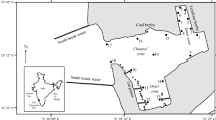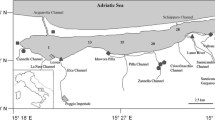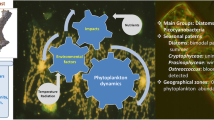Abstract
The implementation of the European Water Framework Directive (WFD) requires the development of ecologically-based classification systems for anthropogenically-induced eutrophication in all types of water bodies. Due to the inherent high temporal and spatial variability of hydrological and geochemical parameters of the coastal waters of the southern Baltic Sea, discrimination between anthropogenic impact and natural variability is necessary. The development of statistical methods for this discrimination was the main aim of this study. These methods were used to derive indicative phytoplankton parameters for different stages of eutrophication for the investigation area. For this purpose, a long-term phytoplankton data series was analysed, which covered a broad salinity and eutrophication gradient. In order to detect eutrophication effects, the analysis was restricted to phytoplankton spring bloom events and to the salinity range between 5 and 10 psu, i.e. superimposing seasonal and hydrodynamic effects were eliminated. An artificial abiotic degradation vector was developed based on four typical water quality parameters. A total of 11 potentially indicative phytoplankton parameters on different taxonomical levels arose from a correlation analysis with this degradation vector. These indicators were then tested for their ability to discriminate between three eutrophication levels. Finally, seven phytoplankton indices could be proposed: total phytoplankton biovolume, the percentage of diatoms and the biovolume of different size ranges of diatoms and one indicative species (Woronichinia compacta).





Similar content being viewed by others
References
Abdullah, M. I. & M. Danielsen, 1992. Chemical criteria for marine eutrophication with special reference to Oslofjord, Norway. Hydrobiologia 235–236: 711–722.
Aguilera, P. A., H. Castro, A. Rescia & M. F. Schmitz, 2001. Methodological development of an index of coastal water quality: application in a tourist area. Environmental Management 27: 295–301.
Arhonditsis, G., M. Karydis & G. Tsirtsis, 2003. Analysis of phytoplankton community structure using similarity indices: a new methodology for discriminating among eutrophication levels in coastal marine ecosystems. Environmental Management 31: 619–632.
Bodeanu, N., 1993. Microalgal blooms in the Romanian area of the Black Sea and contemporary eutrophication conditions. In Smayda, T. J. & Y. Shimizu (eds), Toxic Phytoplankton Blooms in the Sea. Elsevier, Amsterdam: 203–209.
Braarud, T., 1974. The natural history of the Hardangerfjord. 2. The fjord effect upon the phytoplankton in late autumn to early spring, 1955–56. Sarsia 55: 99–114.
Bricker, S. B., J. G. Ferreira & T. Simas, 2003. An integrated methodology for assessment of estuarine trophic status. Ecological Modelling 169: 39–60.
Carstensen, J., U. Helminen & A.-S. Heiskanen, 2004. Typology as a structuring mechanism for phytoplankton composition in the Baltic Sea. Coastline Reports 4: 55–64.
Cloern, J. E., 2001. Our evolving conceptual model of the coastal eutrophication problem. Marine Ecology Progress Series 210: 223–253.
Conley, D. J., C. L. Schelske & E. F. Stoermer, 1993. Modification of the biogeochemical cycle of silica with eutrophication. Marine Ecology Progress Series 101: 179–192.
Danilov, R. A. & N. G. A. Ekelund, 2001. Comparative studies on the usefulness of seven ecological indices for the marine coastal monitoring close to the shore on the Swedish East coast. Environmental Monitoring and Assessment 66: 265–279.
De Jonge, N., 1988. The abiotic environment. In Baretta, J. W. & P. Ruardij (eds), Tidal Flat Estuaries Simulation and Analyses of the Ems Estuary. Springer-Verlag, Berlin: 14–27.
Dettmann, E. H., 2001. Effect of water residence time on annual export and denitrification of nitrogen in estuaries: a model analysis. Estuaries 24: 481–490.
Gasiūnaitė, Z. R., A. C. Cardoso, A. S. Heiskanen, P. Henriksen, P. Kauppila, I. Olenina, R. Pilkaityte, I. Purina, A. Razinkovas, S. Sagert, H. Schubert & N. Wasmund, 2005. Seasonality of coastal phytoplankton in the Baltic Sea: influence of salinity and eutrophication. Estuarine Coastal and Shelf Science 65: 239–252.
Gray, J. S., 1992. Eutrophication in the sea. In Colombo, G., I. Frerrari, V. U. Ceccherelli & R. Rossi (eds), Marine Eutrophication and Population Dynamics. Olsen & Olsen, Fredensborg, Denmark: 3–15.
Hajdu, S., L. Edler, I. Olenina & B. Witek, 2000. Spreading and establishment of the potentially toxic dinoflagellate Prorocentrum minimum in the Baltic Sea. International Review of Hydrobiology 85: 561–575.
HELCOM, 2001. COMBINE-manuals of HELCOM; Part C: Programme of monitoring of eutrophication and its effects. http://sea.helcom.fi/Monas/CombineManual2/PartC/C_Content.htm
Johansson, M., E. Gorokhova & U. Larsson, 2004. Annual variability in ciliate community structure, potential prey and predators in the open northern Baltic Sea proper. Journal of Plankton Research 26: 67–80.
Karydis, M., 1996. Quantitative assessment of eutrophication: a scoring system for characterising water quality in coastal marine ecosystems. Environmental Monitoring and Assessment 41: 233–246.
Larsson, U., R. Elmgren & F. Wulff, 1985. Eutrophication and the Baltic Sea: causes and consequences. Ambio 14: 9–14.
Nehring, D., 1992. Inorganic phosphorus and nitrogen compounds as driving forces for eutrophicaqtion in semi-enclosed seas. ICES Marine Science Symposia 195: 507–514.
Nixon, S. W., 1995. Coastal marine eutrophication: a definition, social causes, and future concerns. Ophelia 41: 199–219.
Peinert, R., A. Saure, P. Stegmann, C. Stienen, H. Haardt & V. Smetacek, 1982. Dynamics of primary production and sedimentation in a coastal ecosystem (Kiel Bight). Netherlands Journal of Sea Research 16: 276–289.
Radach, G., J. Berg & E. Hagmeier, 1990. Long-term changes of the annual cycles of meteorological, hydrographic, nutrient and phytoplankton time series at Helgoland and at LV ELBE 1 in the German Bight. Continental Shelf Research 10: 305–328.
Reimers, H.-C., 2005. Typologie der Küstengewässer der Nord- und Ostsee. In Feld, C., S. Rödiger, M. Sommerhäuser & G. Friedrich (eds), Typologie, Bewertung und Management von Oberflächengewässern, Vol 11. Limnologie aktuell: 37–45.
Rieling, T., S. Sagert, M. Bahnwart, U. Selig & H. Schubert, 2003. Definition of seasonal phytoplankton events for analysis of long term data from coastal waters of the southern Baltic Sea with respect to the requirements of the European Water Framework Directive. In Brebbia, C. A., D. Almorza & D. Sales (eds), Water Pollution VII—Modelling, Measuring and Prediction. WIT Press, Boston: 103–114.
Rönnberg, C. & E. Bonsdorff, 2004. Baltic Sea eutrophication: area-specific ecological consequences. Hydrobiologia 514: 227–241.
Rosenberg, R., R. Elmgren, S. Fleischer, P. Jonssen, G. Persson & H. Dahlin, 1990. Marine eutrophication case studies in Sweden. Ambio 19: 102–108.
Rott, E., 1981. Primary productive and activity coefficients of the phytoplankton of a mesotrophic soft-water lake (Piburger See, Tirol, Australia). Internationale Revue der gesamten Hydrobiologie 66: 1–27.
Sagert, S., D. K. Jensen, P. Henriksen, T. Rieling & H. Schubert, 2005. Integrated ecological assessment of Danish Baltic Sea coastal areas by means of phytoplankton and macrophytobenthos. Estuarine Coastal and Shelf Science 63: 109–118.
Schernewski, G. & M. Wielgat, 2004. Towards a typology for the Baltic Sea. Coastline Reports 2: 35–52.
Schiewer, U., 1998. 30 years’ eutrophication in shallow brackish waters—lessons to be learned. Hydrobiologia 363: 73–79.
Schubert, H., S. Sagert & R. M. Forster, 2001. Evaluation of the different levels of variability in the underwater light field of a shallow estuary. Helgoland Marine Research 55: 12–22.
Smetacek, V., U. Bathmann, E. M. Nöthig & R. Scharek, 1991. Coastal eutrophication: causes and consequences. In Mantoura, R. C. F., J.-M. Martin & R. Wollast (eds), Ocean Margin Processes in Global Change. John Wiley & Sons, Chichester: 251–279.
Sommer, U., U. Gaedke & A. Schweizer, 1993. The first decade of oligotrophication of Lake Constance. II. The response of phytoplankton taxonomic composition. Oecologia 93: 276–284.
Sommer, U., Z. M. Gliwicz, W. Lampert & A. Duncan, 1986. The PEG-model of seasonal succession of planktonic events in freshwaters. Archiv für Hydrobiologie 106: 433–471.
ter Braak, C. J. F. & P. Šmilauer, 2002. CANOCO Reference Manual and CanoDraw for Windows user’s guide. Software for Canonical Community Ordination (version 4.5). Microcomputer Power, Ithaca NY, USA: 1–500.
Tsirtsis, G. & M. Karydis, 1998. Evaluation of phytoplankton community indices for detecting eutrophic trends in the marine environment. Environmental Monitoring and Assessment 50: 255–269.
Utermöhl, H., 1958. Zur Vervollkommnung der quantitativen Phytoplankton-Methodik. International Association of Theoretical and Applied Limnology Communications 9: 1–38.
van den Hoek, C., H. M. Jahns & D. G. Mann, 1993. Algen. 3., Thieme, Stuttgart: 411 pp.
Vollenweider, R. A., F. Giovanardi, G. Montanari & A. Rinaldi, 1998. Characterization of the trophic conditions of marine coastal waters with special reference to the NW-Adriatic Sea: proposal for a trophic scale, turbidity and generalized water qualitiy index. Environmetrics 9: 329–357.
Wasmund, N., A. Andrushaitis, E. Lysiak-Pastuszak, B. Müller-Karulis, G. Nausch, T. Neumann, H. Ojaveer, I. Olenina, L. Postel & Z. Witek, 2001. Trophic status of the south-eastern Baltic Sea: a comparison of coastal and open areas. Estuarine Coastal and Shelf Science 53: 849–864.
Wasmund, N. & V. Kell, 1991. Characterization of brackish coastal waters of different trophic levels by means of phytoplankton biomass and primary production. Internationale Revue der gesamten Hydrobiologie 76: 361–370.
Wasmund, N., G. Nausch & W. Matthaeus, 1998. Phytoplankton spring blooms in the southern Baltic Sea—spatio-temporal development and long-term trends. Journal of Plankton Research 20: 1099–1117.
Wasmund, N., G. Nausch, L. Postel, Z. Witek, M. Zalewski, S. Gromisz, E. Lysiak-Patuszak, I. Olenina, R. Kavolyte, A. Jasinskaite, B. Müller-Karulis, A. Ikauniece, A. Andrushaitis, H. Ojaveer, K. Kallaste & A. Jaanus, 2000. Tropic status of coastal and open areas of the south-eastern Baltic Sea based on nutrient phytoplankton data from 1993–1997. Marine Science Reports 38: 1–86.
Wasmund, N., F. Pollehne, L. Postel, H. Siegel & M. L. Zettler, 2004. Biologische Zustandseinschätzung der Ostsee im Jahre 2003. Marine Science Reports 60: 1–94.
Wasmund, N., F. Pollehne, L. Postel, H. Siegel & M. L. Zettler, 2005. Biologische Zustandseinschätzung der Ostsee im Jahre 2004. Marine Science Reports 64: 1–78.
Wasmund, N. & U. Schiewer, 1994. Overview on ecology and biological production of phytoplankton from the Darss-Zingst Bodden chain (southern Baltic). [Überblick zur Ökologie und Produktionsbiologie des Phytoplanktons der Darß-Zingster-Boddenkette]. Rostocker Meeresbiologische Beiträge 2: 41–60.
Wasmund, N. & S. Uhlig, 2003. Phytoplankton trends in the Baltic Sea. ICES Journal of Marine Science 60: 177–186.
Wasmund, N., M. Zalewski & S. Busch, 1999. Phytoplankton in large river plumes in the Baltic Sea. ICES Journal of Marine Science 56: 23–32.
WFD 2000/60/EC; Directive 2000/60/EC of the European parliament and of the council of 23 October 2000 establishing a framework for Community action in the field of water policy. Official Journal of the European Communities L 327/1: 1–72.
Zurlini, G., 1996. Multiparametric classification of trophic conditions. The OECD methodology extended: combined probabilities and uncertainties—application to the North Adriatic Sea. Science of the Total Environment 182: 169–185.
Acknowledgments
The authors are grateful for financial support by the BMBF (Bundesministerium für Bildung und Forschung, Germany, ELBO-Az 0330014), the LUNG (Landesamt für Umwelt, Naturschutz und Geologie Mecklenburg-Vorpommern) and the European Commission (CHARM-EVK3-CT-2001- 00065). Special thanks go to Mandy Bahnwart and Norbert Wasmund for their great contributions to compilation and quality assurance of the phytoplankton database.
Author information
Authors and Affiliations
Corresponding author
Additional information
Guest editors: A. Razinkovas, Z. R. Gasiūnaitė, J. M. Zaldivar & P. Viaroli
European Lagoons and their Watersheds: Function and Biodiversity
Rights and permissions
About this article
Cite this article
Sagert, S., Rieling, T., Eggert, A. et al. Development of a phytoplankton indicator system for the ecological assessment of brackish coastal waters (German Baltic Sea coast). Hydrobiologia 611, 91–103 (2008). https://doi.org/10.1007/s10750-008-9456-3
Published:
Issue Date:
DOI: https://doi.org/10.1007/s10750-008-9456-3




